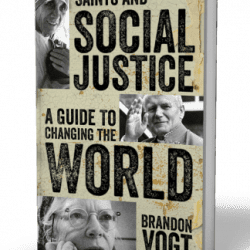I’ve talked quite a bit about the trends of rising inequality in America, and I thought I would continue that discussion, going a lot deeper. For a start, let’s drag out the old reliable chart developed by Paul Krugman from an influential paper by Picketty and Saez (2003), measuring the share of the richest 10 percent in national income:
Basically, following the New Deal and the war, wage compression gave rise to three decades of strong economic growth that was broadly shared, with no rise in inequality. That era ended in the 1970s, and now we have returned to levels of inequality not seen since the Gilded Age. I will argue that a lot of it has to do with the kinds of policies adopted since the 1980s, and the changing social norms that paved the way for a return to Gilded era laissez-faire liberalism alongside the mantra that “greed is good” insofar as the whole economy benefits. But everybody did not benefit.
Catholic social teaching has much to say on inequality. In Quadragesimo Anno, Pope Pius XI wrote: “riches that economic-social developments constantly increase ought to be so distributed among individual persons and classes that the common advantage of all…. one class is forbidden to exclude the other from sharing in the benefits.” Ideally, workers would “share in the ownership or management or participate in some fashion in the profits received”. Pope John XXIII in Mater Et Magistra argued that “the economic prosperity of a nation is not so much its total assets in terms of wealth and property, as the equitable division and distribution of this wealth.”
Basically, and in stark contrast in preceding decades, the wealth generated was not shared with workers. A number of recent economic papers have discussed these broad trends, including Krugman (2007), Piketty and Saez (2003), and Levy and Temin (2007). Let’s start with the facts.
First, we need to figure out how much productivity grew since 1973. Even this is not uncontroversial. If you look the standard BLS measure of productivity of the non-farm business sector, you will discover that it rose by 80 percent between 1973-06. But, as pointed out by Dean Baker (2007), this tends to overstate the story for a number of reasons. What we need is a measure of “usable” productivity, or productivity that can be translated into higher wages and living standards. That means we must: (i) adjust for the fact that the non-farm business sector is not the whole economy, (ii) net out the portion of output that goes simply to depreciation, and (iii) adjust for the faster rise in consumer goods than investment goods. Doing all this, we arrive at a smaller increase of 47.9 percent. But even that overstates the amount available for wage increases as non-wage costs (largely rising payroll taxes and especially health care costs) rose rapidly. About 36 percent is left for wage increases.
In fact, real median household income (adjusted for inflation) rose by 16 percent over this period. That’s not much (less than half a percent a year), but that too is overstated. Much of the increase reflects the entry of women into the labor force, or from part-time to full-time employment. If you look just at the data for men, their real earnings in 2005 were slightly lower than in 1973. Think about that– the median male worker saw no improvement in his living standards in over 30 years. This of course has profound implications for the “living wage” in Catholic social teaching. And the news gets worse. The number for men is biased upwards by the fact that the workforce is older in 2005 than it was in 1973. If we look at earnings for men between 35-44, you will see something quite staggering: their predecessors in 1973 were 12 percent better off than they are today.
What’s going on here? The standard economic explanations for middle class stagnation and widening inequality include skill-biased technical change (the idea that new technology puts a premium on brain over brawn), trade and globalization, and rising immigration. And these are all plausible candidates. Still, they cannot fully explain what happened for they are all theories of wage differentials between skilled and unskilled, or educated and less educated. But the median income for male college graduates since 1973 increased by 17 percent– clearly better than his non-college educated peers, but he too, is left behind. Plus, Europe faced the same technology and globalization shocks, and yet did not witness rising disparities on this scale.
True, Europe did not open its doors to immigration to the same extent, but (as I’ve discussed before), the best estimates are that immigration has a small effect on the wage of high-school dropouts, and not at all on any other group. Labor economist David Card argues that there is “surprising little relationship between immigration and less-skilled wages” while the upper bound is provided by the work of George Borjas and Larry Katz, which still only shows an effect of less than 4 percent on low-skilled wages.
So, if the standard economic explanations don’t fit, what does? I believe an institutional change took place, leading to a society more accepting of great wealth disparities. As shown by MT economists Frank Levy and Peter Temin, inequality is affected greatly by economic institutions and social norms. Between the late 1940s and early 1970s, a set of institutions ensured that wages rose with productivity; these institutions began with the New Deal and the war, but they continued afterwards. As noted by Piketty and Saez, the fact that compression of wages survived after the war is powerful evidence that institutions and social norms were important.
Levy and Temin dub these institutions the “Treaty of Detroit’ whereby strong unions ensured wages rose with productivity and workers received health and retirement benefits. Companies in turn got industrial peace and productive workers. At the same time, the government cemented this arrangement with progressive taxes and a high minimum wage. This implicit bargain is fully compatible with Catholic social teaching, especially the corporatist framework of Quadragesimo Anno, in which Pope Pius XI discussed an organic conception of social unity, where society is organized as a collection of groups that work together to achieve the common good. By this model, corporations, labor unions and government would bargain over wages, hours worked, and working conditions.
The problem is that in the 1970s, the ‘Treaty of Detroit” fell apart in the wake of a global slowdown, and also that social norms changed. As productivity declined, and unemployment and inflation rose precipitously, a movement that would later come to power under the leadership of Ronald Reagan argued that a return to laissez-faire liberalism, combined with de-unionization and a reduction in the role of government, would bring about economic nirvana. Accordingly, tax and welfare policies were skewed toward the rich, and unions lost power. Unionization rates declined from 30 percent in 1960 to 13 percent by 1999. Social norms also changed. Instead of sharing and cooperating, the “greed is good” mantra became the new norm. Harking back to the liberal philosophy of the Gilded Age, personal self-interest was held to maximize efficiency and attain virtue and freedom.
A illustrative example provided by Krugman contrasts GM in 1969 with Walmart today. Walmart’s non-supervisory employees receive about $18,000 a year, less than half (in real terms) of what GM workers earned in the earlier period. Walmart’s CEO was paid $23 million in 2005, five times more (in real terms) than GM’s CEO a quarter of a century earlier. Solidarity simply went through the window. When you look at who is gaining from the productivity increase, it’s quite stark. The top 1 percent grew richer. The top 0.1 percent saw a fivefold increase in real income. The top 0.01 percent saw a sevenfold increase in real income.
Many Catholics seem to have bought into the myth that the free market social norms and the policies of Reagan and his successors was somehow beneficial to the economy, and to the common good, and they mis-quote Centissimus Annusto make that point. But there is no trickle down, only increasing inequality; no concept of striving for the common good, as more and more people get left behind. It’s time to re-assess the Reaganesque mantra.
References:
Dean Baker, 2007, “The Productivity to Paycheck Gap: What the Data Show,” Center for Economic and Policy Research.
Paul Krugman, 2007, The Conscience of a Liberal.
Frank Levy and Peter Temin, 2007, “Inequality and Institutions in 20th century America,” Working Paper 01-17, Massachusetts Institute of Technology.
Thomas Picketty and Emmanuel Saez, 2001, “Income Inequality in the United States,” Quarterly Journal of Economics, Vol 116, No. 4 (Nov), pp 1493-1525.












